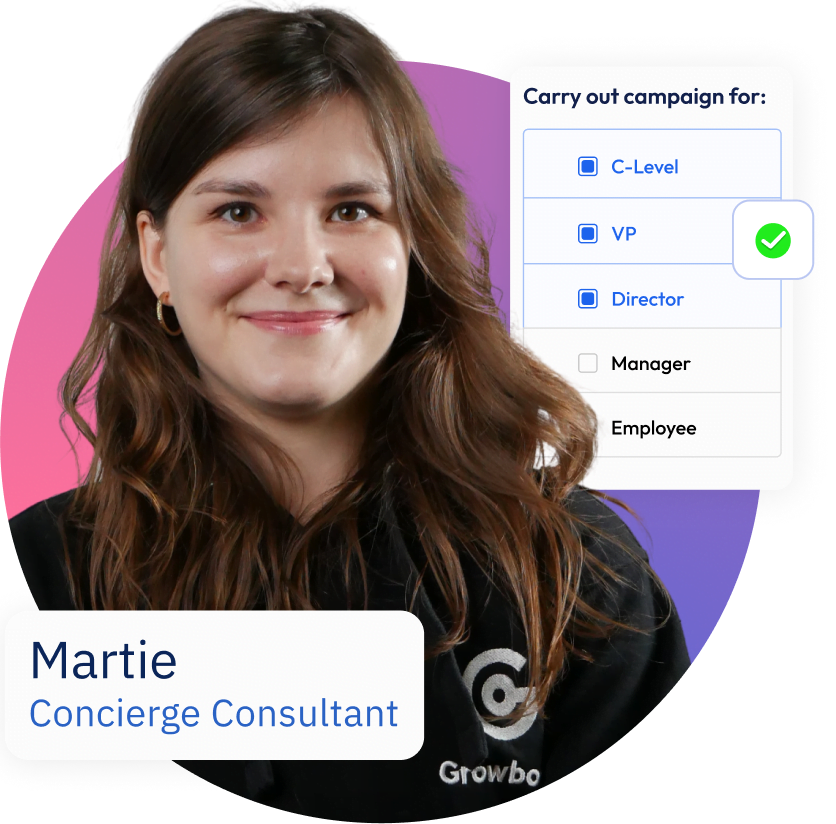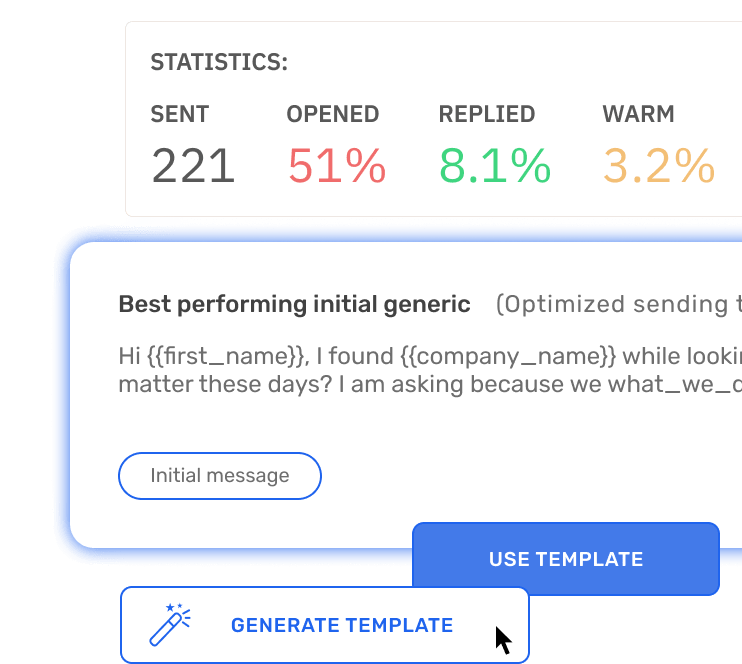Prospecting vs lead generation are often used interchangeably in the B2B sales context, but they represent distinct elements in the sales arsenal.While both are quintessential in obtaining and converting potential customers, understanding their differences is not just a matter of semantics; it’s about recognizing how each uniquely contributes to the broader context of a company’s sales and marketing strategy.By the end of this article, you will be better equipped to understand these processes and optimize them for your business goals, appreciating the nuances of prospecting vs lead generation
Another effective strategy is to host and participate in industry-related events, webinars, and workshops.These platforms not only provide an opportunity to showcase expertise and thought leadership but also allow direct interaction with potential leads. Engaging in partnerships with other businesses for co-marketing activities can expand reach to new audiences.Furthermore, using lead magnets like free trials, ebooks, or whitepapers can be effective in attracting potential customers by offering them valuable information or services in exchange for their contact details.
The right mix of these elements ensures a robust prospecting process that can significantly enhance sales results.
Furthermore, diversifying the types of content used in lead generation campaigns is crucial.Beyond traditional blog posts and articles, incorporating a variety of formats like infographics, podcasts, videos, and webinars can cater to different preferences within your target audience.Regularly updating and repurposing existing content can also keep your material fresh and relevant, further enhancing its effectiveness in lead generation.
Key Takeaways
- Lead generation and sales prospecting are integral to the B2B sales process, focusing on attracting and engaging potential customers.
- Lead generation involves attracting prospects broadly, while sales prospecting engages qualified leads to determine their potential for sales.
- Successful lead generation strategies include content marketing, SEO, and PPC advertising, aiming to convert the right audience into leads.
- Sales prospecting relies on targeted outreach, personalized communication, consistent follow-up, and efficient use of technology and tools.
- Collaboration between sales and marketing teams enhances the effectiveness of lead generation and prospecting activities.
- Tools like CRM systems, email marketing software, and analytics are important for lead management and campaign tracking.
- Advanced prospecting techniques leverage data and social selling to connect with and engage prospects more efficiently.
- Personalization and understanding buyer personas are essential to attract and resonate with the target audience.
- Measuring the success of lead generation and prospecting is done by tracking conversion rates, lead volume, and ROI among other KPIs.
- The digital age has expanded opportunities for lead generation and prospecting through channels like social media, SEO, and email marketing.
- Content plays a significant role in attracting customers and establishing thought leadership.
- Lead nurturing strategies are vital for converting initial interest into sales, requiring engagement throughout the customer decision-making journey.
- Lead generation and sales prospecting should align with business goals to support strategic objectives.
leave no lead unexplored
Every potential client within reach
- 180m+ contacts
- CRM integrations
- 23 Prospect filters
- 15 Company filters
Definition of Lead Generation
Lead generation is the art and science of attracting and converting strangers into prospects who have indicated an interest in your company’s product or service. It is a vital component in the sales cycle, creating a pipeline of potential clients that businesses can engage with. Effective lead generation can significantly impact a company’s bottom line by ensuring a consistent influx of prospects for the sales team to pursue.Definition of Sales Prospecting
Sales prospecting, on the other hand, involves identifying potential customers, or prospects, and developing a database of likely customers. It is an active part of the selling process that often follows lead generation. Prospecting includes outreach like cold calling or emailing to establish initial contact and gauge a prospect’s interest level. While it is more direct and personable than lead generation, sales prospecting also requires a strategic approach to be successful.Prospecting vs Lead Generation: Differences
The primary difference between lead generation and sales prospecting lies in their focus points and methodologies. Lead generation is about casting a wide net to attract as many leads as possible before qualifying them; sales prospecting is about starting with leads who are already partially qualified and nurturing them into sales-ready prospects.| Lead Generation | Sales Prospecting |
| Focuses on attracting a large volume of leads. | Focuses on engaging with qualified leads to assess their potential. |
| Often involves broader marketing strategies. | Is more targeted and personalized in approach. |
| Captures interest through various channels. | Requires direct engagement and follow-up. |
| Is generally the first step in a sales process. | Comes after an initial interest or lead is generated. |
Strategies for Successful Lead Generation
Effective lead generation strategies are those that attract the right audience, offer value, and convert visitors into leads. To enhance strategies for successful lead generation, it’s crucial to integrate a robust digital presence with traditional marketing methods. This involves creating a dynamic and user-friendly website, active engagement on social media platforms, and employing email marketing with segmented lists for different audience groups.Additionally, leveraging video marketing can significantly boost engagement, as visual content often resonates more effectively with audiences.It’s vital to ensure that all digital content is optimized for search engines to improve visibility and reach. Incorporating customer testimonials and case studies on various platforms can also build credibility and trust, encouraging more prospects to engage with your brand.Small businesses that have blogs gain 126% more lead growth compared to those that don’t.
Source: salesmate.io
Key Components of Sales Prospecting
Just as lead generation has its strategies, sales prospecting has key components that, when executed well, drive successful conversions. Among these components are:- Targeted outreach
- Personalized communication
- Consistent follow-up
- Use of technology and tools
- Research and preparation
| Component | Description |
| Targeted Outreach | Identifying the right prospects based on predefined criteria. |
| Personalized Communication | Tailoring messages to meet the specific needs of each prospect. |
| Consistent Follow-Up | Regularly contacting prospects to keep the dialogue going. |
| Technology and Tools | Utilizing CRMs and prospecting tools to streamline the process. |
| Research and Preparation | Gathering insights about prospects to make informed outreach efforts. |
Collaboration Between Sales and Marketing Teams
Successful lead generation and sales prospecting are often the result of well-coordinated efforts between sales and marketing teams. When both departments work towards a common goal and share insights, strategies can be fine-tuned for better results. Marketing can generate leads with targeted content and campaigns, while sales can take these leads through the funnel with personalized outreach.Regular meetings and shared KPIs can help both teams stay aligned and focused on the common business goals. Utilizing CRM and marketing automation tools effectively can also facilitate this alignment by providing a unified view of the customer journey and enabling better coordination between marketing and sales activities.Lead Generation Tools and Software
Lead generation is an intricate process, often necessitating the right blend of tools and software to achieve optimal results. In the digital era, various platforms provide immense help in automating and streamlining this task. CRM systems, email marketing software, and analytics tools are crucial in tracking leads’ activities and engagements. Some of the top software used in lead generation include HubSpot, Marketo, and Salesforce.- HubSpot: Offers a full stack of software for marketing, sales, and customer service, with a completely free CRM at its core.
- Marketo: A marketing automation platform known for its lead management and scalability.
- Salesforce: Provides a suite of enterprise applications focused on customer service, marketing automation, analytics, and application development.
For 34% of B2B businesses, SEO is the top source of leads.
Source: inboundblogging.com
Advanced Sales Prospecting Techniques
Sales prospecting has evolved significantly with the advent of new technologies and strategies. Beyond the regular outreach and follow-up, modern sales teams are now employing data-driven approaches and social selling to connect with prospects more efficiently. Advanced techniques like predictive analytics can help in anticipating buyer trends and behavior, enabling salespeople to target prospects with precision. With the right set of skills and tools, prospecting can become a more productive and less onerous task.- Social Media Engagement: Using platforms like LinkedIn to build relationships and engage with potential leads.
- Account-Based Marketing: Targeting key accounts with tailored campaigns and messaging.
- Sales Intelligence Tools: Leveraging data to gain insights into prospect behaviors and preferences.
Optimizing the Lead Generation Process
For optimized lead generation, it is critical to continually analyze and refine strategies. This can involve A/B testing different messages and channels, using analytics to track engagement and conversion, and staying abreast of market trends and competitive angles.Using data
Utilizing advanced data analytics tools can provide deep insights into customer behaviors, preferences, and trends, enabling businesses to tailor their lead generation strategies more effectively.Such a data-driven approach helps in refining targeting criteria, customizing content, and determining the most effective channels for reaching potential leads.Additionally, gathering and analyzing customer feedback can offer invaluable insights into what resonates with the audience, allowing for the fine-tuning of messaging and offers.Using automation
Automation plays a pivotal role in streamlining the lead generation process. Implementing marketing automation tools can help in efficiently managing and nurturing leads at scale.These tools can automate repetitive tasks such as email marketing, social media postings, and lead scoring, freeing up time for more strategic activities.Automation also ensures consistent engagement with potential leads, keeping them warm and gradually moving them through the sales funnel. It’s important to integrate these tools with CRM systems to ensure a seamless flow of information and enable a unified view of the lead journey.Prospecting Challenges and Solutions
While prospecting is an essential part of the sales process, it presents its own set of challenges. Sales representatives often struggle with time management, finding the right balance between quantity and quality of leads, or even facing rejection. To overcome these hurdles, you can try solutions such as:- Better Qualification: Invest more in qualifying leads to ensure time is spent on prospects with higher conversion potential.
- Effective Tools: Employ CRM and prospecting tools to manage and track interactions more efficiently.
- Training and Resources: Provide sales reps with adequate training and resources to deal effectively with rejections and maintain morale.
Lead Generation Techniques That Work
When it comes to lead generation, some techniques stand out for their ability to generate quality leads consistently. These include content marketing, offering high-value resources like ebooks or webinars, optimizing websites for conversions with strong call-to-action prompts, and engaging in strategic networking both online and offline.Strong relationships born from trust and value lead to higher conversion rates and customer loyalty, which is paramount in the B2B space.The Significance of Buyer Personas
At the heart of both lead generation and sales prospecting lies the understanding of buyer personas. Buyer personas represent semi-fictional characters that encapsulate the attributes of an ideal customer. They are fundamental to crafting targeted strategies that resonate with potential clients.Measuring Success in Lead Generation and Prospecting
Understanding whether lead generation and prospecting efforts are successful hinges on meticulously tracking specific metrics and KPIs. These include lead conversion rates, the total number of leads generated, sales-accepted leads, and the overall ROI from lead generation campaigns.| Key Performance Indicator | Purpose |
| Conversion Rates | Measures the percentage of leads that turn into customers. |
| Volume of Leads | Tracks the total number of leads generated over a period. |
| Sales-Accepted Leads | The number of leads the sales team accepts as quality prospects. |
| ROI of Lead Gen Campaigns | Evaluates the profitability of the lead generation activities. |
22% of B2B marketers nurture leads weekly.
Source: MarketingSherpa.com
Lead Generation and Prospecting in the Digital Age
The onset of the digital age has forever changed the landscape of lead generation and sales prospecting. An array of digital channels and platforms have become invaluable assets that businesses leverage for these activities. From social media to SEO and email marketing, the virtually limitless reach of the internet provides a fertile ground for identifying and nurturing potential leads.Reach More with Less Effort
Connect with Potential Clients at scale
- AI message generator
- E-mail verification
- Multichannel sequences
- A/B testing
The Role of Content in Lead Generation
Crafting content that tells a compelling story about your brand, products, or services can significantly enhance engagement with your target audience.This approach helps in building a connection with potential customers, as they are more likely to remember and respond to content that resonates on a personal level.However, the content must be highly relevant and valuable to the audience. This means understanding their challenges, interests, and needs, and providing solutions or insights that address these.Content that directly speaks to the pain points of your audience and offers tangible benefits is more likely to generate leads.B2B companies that blog have generated 67% more leads as compared to the companies that do not blog.
Source: demandsage.com
Personalization in Sales Prospecting
In the era of information overload, personalization has become a non-negotiable aspect of sales prospecting. Today’s B2B buyers expect a tailored approach that acknowledges their unique challenges and needs.Lead Nurturing Strategies
Effective lead nurturing strategies are centered around consistent and personalized communication with your leads. It’s important to recognize that each lead is at a different stage in the buying journey, and thus requires a tailored approach.Segmenting your leads based on their behavior, needs, and engagement level allows for more targeted communication.For instance, sending personalized emails with content relevant to their stage in the decision-making process can significantly increase the chances of conversion.This approach also involves timely follow-ups, offering additional information or assistance that might nudge the lead closer to a sale. Utilizing outbound sales automation tools can aid in delivering these personalized messages at scale, ensuring no lead is neglected.
Additionally, building a strong relationship with leads is key to successful nurturing.This means going beyond transactional interactions and striving to provide real value in every communication.Educational content, industry insights, and helpful resources can position your brand as a trusted advisor in your field. It’s also important to regularly assess and adapt your nurturing strategies based on feedback and changing customer needs.
Reach More with Less Effort
Connect with Potential Clients at scale
- AI message generator
- E-mail verification
- Multichannel sequences
- A/B testing
Aligning Lead Generation and Prospecting with Business Goals
Aligning lead generation and prospecting with business goals requires a strategic approach that connects these activities directly to the company’s overall objectives.This starts with a clear understanding of the business goals, whether it’s market expansion, increasing revenue, launching a new product, or enhancing brand recognition.Once these goals are defined, the lead generation and prospecting strategies should be tailored to support them.For example, if the goal is to enter a new market, lead generation efforts might focus on content and campaigns that appeal to that specific demographic, while prospecting strategies could involve researching and reaching out to key players in that market.It’s crucial to set specific, measurable goals for lead generation and prospecting efforts, such as a targeted number of leads or a specific conversion rate, to ensure alignment with broader business objectives.no prior experience & time required
Find your winning outbound formula with Concierge
- 95% activities on our behalf
- Avoid in-house SDR hire
- Learn & Take over anytime
- Numerous A/B tests






























